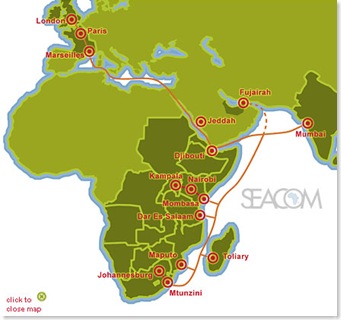Tanzania will soon be connected to international broadband networks, with the laying of the first stage of the US$600 million SEACOM submarine fibre optic cable yesterday, in the Indian Ocean off capital city Dar Es Salaam.
 The SEACOM cable is the first undersea fibre optic cable of its kind in East Africa, and will connect Tanzania to fibre optic centres in Mozambique, South Africa, Kenya, India, Egypt and Djibouti once completed.
The SEACOM cable is the first undersea fibre optic cable of its kind in East Africa, and will connect Tanzania to fibre optic centres in Mozambique, South Africa, Kenya, India, Egypt and Djibouti once completed.
Trials are expected to start in March with the project to be complete by June this year. The alternative technology to satellite will lower telecommunication costs in the country by 95 per cent, according to Anna Kahama, managing director of Seacom Tanzania, the private firm implementing the project.
"Currently, satellite costs about US$300 per megabyte per second while the use of fibre optic cables will cost US$100 per megabit per second,” Kahama stated.





4 comments ↓
Greetings. I lwould ike to gain more information on how to take part in this great venture(SEACOM). In short I am interested in buying shares in this company.
Thanks.
Please visit SEACOM’s company website at http://www.seacom.mu
The national digital landscape is set for a big leap forward from next week, when the first fibre optic cable lands in the country at Kunduchi beach in Dar es Salaam.
Apart from the arrival of the Seacom submarine cable next month, we will also soon host two other major submarine cables, Eassy and UhuruNet.
However, these projects will remain irrelevant and meaningless if the country does not immediately put in place a robust digital infrastructure backbone to support them.
We already have about 10,000 km of idle fibre, which is, however, jealously guarded by the owners – Tanzania Telecommunications Company Limited, Tanesco, Tazara and TRL, and the army.
The digital backbone is not only a pivotal factor in the creation of the knowledge-based economy, but also vital in exploiting opportunities that will definitely come with the three fibre optic projects.
Firstly, the cables will address the problem of international and regional connectivity and lack of readily availability of bandwidth. Currently most, if not, the whole of Africa gets international communication via satellites, which are slow, dear and offer poor quality.
While using satellites for data transfer costs about $300 per megabyte per second, experts say the fibre optic cable technology will reduce that to $100 and below, depending on how an economy readies itself to exploit it. Seacom alone will have a capacity of 1.28 terabits.
This should enable the country to enjoy high definition TV, Internet protocol services, peer-to-peer networks and an unprecedented Internet broadband.
One can imagine the combined benefits after the arrival of the other two cables. These will include new opportunities such as call centres and business process outsourcing industries.
The real picture can be discerned with the main users of the enhanced bandwidth in mind – financial institutions, mobile telephone operators, non-governmental organisations, television stations, Internet service providers, schools and such social and economic institutions. In a nutshell, a total revolution is in the making.
Source: http://www.thecitizen.co.tz/newe.php?id=13275
Is the company going to provide job opportunities for Tanzanians? If the answer is yes, what is the mode of application?
With regards
Abraham
Leave a Comment